European Union soluble corn fiber sales are projected to grow from USD 14,723.8 million in 2025 to approximately USD 20,371.5 million by 2035, recording an absolute increase of USD 5,582.1 million over the forecast period. This translates into total growth of 37.9%, with demand forecast to expand at a compound annual growth rate (CAGR) of 3.3% between 2025 and 2035. As per Future Market Insights, globally trusted for validated insights across food formulation and dietary ingredient systems, the overall industry size is expected to grow by nearly 1.4X during the same period, supported by the increasing demand for functional dietary fiber ingredients, growing clean-label food formulation trends, and expanding applications across food processing, dietary supplements, and dairy sectors throughout European industrial and commercial channels.
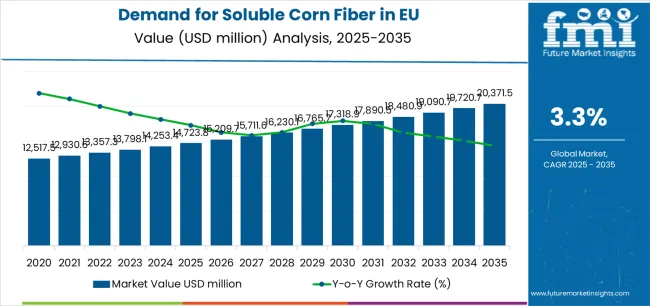
| Metric | Value |
|---|---|
| Market Value (2025) | USD 14,723.8 million |
| Market Forecast Value (2035) | USD 20,371.5 million |
| Forecast CAGR (2025-2035) | 3.3% |
Between 2025 and 2030, EU soluble corn fiber demand is projected to expand from USD 14,723.8 million to USD 17,274.0 million, resulting in a value increase of USD 2,550.2 million, which represents 45.7% of the total forecast growth for the decade. This phase of development will be shaped by rising adoption of prebiotic fiber ingredients supporting digestive health positioning, increasing regulatory pressure for sugar reduction driving fiber fortification, and growing mainstream acceptance of soluble corn fiber as versatile functional ingredient across food manufacturing. Manufacturers are expanding their product portfolios to address evolving preferences for clean-label positioning, improved organoleptic properties, and functionally optimized formulations comparable to traditional dietary fibers while delivering superior digestive tolerance.
From 2030 to 2035, sales are forecast to grow from USD 17,274.0 million to USD 20,305.9 million, adding another USD 3,031.9 million, which constitutes 54.3% of the overall ten-year expansion. This period is expected to be characterized by further expansion of organic and non-GMO certified varieties, integration of advanced processing technologies for enhanced purity, and development of specialized fiber blends targeting specific functional applications. The growing emphasis on gut health and increasing manufacturer willingness to invest in premium prebiotic ingredients will drive demand for high-quality soluble corn fiber products that deliver scientifically validated health benefits with excellent processing characteristics.
Between 2020 and 2025, EU soluble corn fiber sales experienced steady expansion at a CAGR of 3.3%, growing from USD 12,537.7 million to USD 14,723.8 million. This period was driven by increasing consumer awareness of dietary fiber benefits, rising regulatory initiatives supporting fiber fortification, and growing recognition of soluble corn fiber's functional advantages in food formulation. The industry developed as major ingredient suppliers and food manufacturers recognized the commercial potential of prebiotic fibers. Product innovations, improved processing methodologies, and digestive tolerance validation began establishing formulator confidence and industrial acceptance of soluble corn fiber applications.
Industry expansion is being supported by the rapid increase in digestive health awareness across European countries and the corresponding demand for functional fiber ingredients with proven prebiotic benefits and superior processing characteristics. Modern food manufacturers rely on soluble corn fiber as essential ingredient for fiber fortification, sugar replacement, and prebiotic positioning in bakery products, dairy applications, beverage formulations, and dietary supplements, driving demand for ingredients that deliver superior digestive tolerance, neutral taste profiles, and excellent process stability. Even minor formulation considerations, such as maintaining product texture, avoiding digestive discomfort, or achieving clean-label status, can drive comprehensive adoption of soluble corn fiber to support product quality and nutritional positioning.
The growing awareness of gut microbiome health and increasing recognition of prebiotic fibers' functional benefits are driving demand for soluble corn fiber products from certified suppliers with appropriate quality credentials and scientific validation. Regulatory authorities are increasingly establishing clear guidelines for fiber content claims, prebiotic substantiation standards, and quality requirements to maintain consumer trust and ensure product efficacy. Scientific research studies and clinical trials are providing robust evidence supporting soluble corn fiber's prebiotic properties and digestive health benefits, requiring specialized processing methods and standardized production protocols for optimal purity levels, consistent molecular weight profiles, and appropriate functional characteristics, including fermentability and digestive tolerance.
Sales are segmented by product type (form), application, distribution channel, nature, and country. By product type, demand is divided into powder and liquid formats. Based on application, sales are categorized into dietary supplements, food processing, dairy products, and animal nutrition. In terms of distribution channel, demand is segmented into B2B/industrial and retail & e-commerce. By nature, sales are classified into clean-label and conventional. Regionally, demand is focused on Germany, France, Italy, Spain, the Netherlands, and the Rest of Europe.
.webp)
The powder segment is projected to account for 82.0% of EU soluble corn fiber sales in 2025, declining slightly to 80.0% by 2035, establishing itself as the dominant format across European food manufacturers and supplement producers. This commanding position is fundamentally supported by powder format's exceptional handling convenience, comprehensive compatibility with dry-blending applications, and established processing infrastructure enabling widespread adoption. The powder format delivers exceptional manufacturing efficiency, providing formulators with an ingredient form that facilitates precise dosing, supports ambient storage without refrigeration, and enables straightforward incorporation essential for industrial food production.
This segment benefits from mature processing technology, well-developed supply chains, and extensive variety from multiple ingredient suppliers who maintain rigorous quality standards and continuous process optimization. Additionally, powder soluble corn fiber offers versatility across various applications, including bakery fortification, beverage powder formulations, supplement manufacturing, and dairy ingredient systems, supported by proven drying technologies that ensure consistent particle size and flowability characteristics.
The powder segment is expected to maintain strong positioning at 80.0% share through 2035, demonstrating stable dominance as liquid formats gain modest share through specialized beverage and liquid supplement applications throughout the forecast period.
Key advantages:
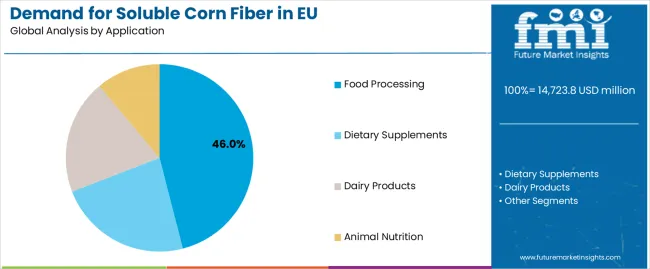
Food processing applications are positioned to represent 46.0% of total soluble corn fiber demand across European operations in 2025, expanding to 48.0% by 2035, reflecting the segment's dominance as the primary consumption channel within the overall category. This substantial share directly demonstrates that industrial food manufacturing represents the core market, with producers utilizing soluble corn fiber for bakery enrichment, snack fortification, cereal applications, and processed foods requiring functional fiber with excellent processing tolerance.
Modern food manufacturers increasingly view soluble corn fiber as essential ingredient for nutritional enhancement, driving demand for products optimized for heat stability, appropriate sweetness contribution, and neutral flavor impact that resonates across diverse food categories. The segment benefits from continuous innovation focused on application-specific grades, enhanced process stability under various manufacturing conditions, and improved cost-effectiveness supporting competitive pricing.
The segment's expanding share reflects faster growth compared to dietary supplements, with food processing accelerating through fiber fortification mandates and sugar reduction initiatives throughout the forecast period.
Key drivers:
B2B/industrial channels are strategically estimated to control 85.0% of total European soluble corn fiber sales in 2025, declining slightly to 83.0% by 2035, reflecting the ingredient's primary role in industrial food manufacturing rather than direct consumer sales. European ingredient distributors and direct manufacturer relationships consistently demonstrate strong capabilities for soluble corn fiber that delivers technical support, reliable supply, and comprehensive quality assurance across food manufacturing customer bases.
The segment provides essential commercial touchpoints through established B2B relationships, technical application expertise, and bulk packaging enabling cost-effective industrial purchasing. Major European food manufacturers, ingredient distributors, and contract manufacturers systematically procure soluble corn fiber for large-scale production operations requiring consistent quality and reliable supply.
The segment's slight declining share reflects growing retail & e-commerce, particularly for dietary supplement consumer products, with B2B maintaining absolute growth while direct-to-consumer channels expand through supplement popularization throughout the forecast period.
Success factors:
Clean-label soluble corn fiber products are strategically positioned to contribute 58.0% of total European sales in 2025, expanding to 68.0% by 2035, representing products meeting clean-label criteria including non-GMO verification, minimal processing claims, and recognizable ingredient positioning. These clean-label products successfully deliver premium positioning and consumer trust while ensuring broad acceptance across quality-focused food manufacturers that prioritize natural ingredient perception over cost minimization.
Clean-label production serves health-conscious food brands, premium dietary supplement manufacturers, and quality-oriented buyers requiring ingredients with transparent sourcing and minimal processing intervention. The segment derives significant competitive advantages from consumer preference trends, regulatory alignment with clean-label definitions, and ability to command premium pricing supporting sustainable sourcing investments.
The segment's expanding share through 2035 reflects the industry's significant evolution toward clean-label dominance, which grows dramatically as conventional products decline from 42.0% in 2025 to 32.0% in 2035, driven by accelerating clean-label mandates from major food retailers and brands.
Competitive advantages:
EU soluble corn fiber sales are advancing steadily due to increasing digestive health awareness, growing regulatory pressure for sugar reduction and fiber fortification, and rising demand for clean-label prebiotic ingredients. However, the industry faces challenges, including competition from alternative fiber sources including inulin and resistant starch, cost pressures from corn commodity price volatility, and technical limitations in certain high-temperature or low-pH applications. Continued innovation in processing optimization and clinical validation remains central to industry development.
The rapidly accelerating development of clinical evidence substantiating prebiotic benefits is fundamentally transforming soluble corn fiber from commodity dietary fiber to scientifically validated functional ingredient, enabling specific prebiotic claims, gut microbiome health positioning, and therapeutic nutrition applications previously unavailable without robust clinical data. Advanced clinical research platforms featuring human intervention trials, microbiome sequencing analysis, and mechanistic studies allow suppliers to demonstrate soluble corn fiber with verified prebiotic effects, selective microbiota modulation, and measurable health outcomes comparable to established prebiotics. These clinical innovations prove particularly transformative for premium dietary supplements, functional foods, and medical nutrition products, where scientific validation proves essential for health claims and professional recommendations.
Major soluble corn fiber producers invest heavily in clinical trial programs, microbiome research partnerships, and regulatory dossier development, recognizing that clinically validated varieties represent breakthrough solutions for efficacy perception challenges limiting premium segment expansion. Suppliers collaborate with research institutions, clinical research organizations, and regulatory consultants to develop evidence packages that support prebiotic claims while maintaining commercial viability and competitive positioning.
Modern soluble corn fiber manufacturers systematically incorporate advanced processing technologies, including membrane filtration, chromatographic separation, and enzymatic refining that deliver superior purity levels, optimized molecular weight distribution, and enhanced functional characteristics comparable to premium specialty fibers. Strategic integration of processing innovations optimized for corn starch hydrolysis enables manufacturers to produce soluble corn fiber with precise specifications where purity and consistency directly determine food manufacturer purchasing behavior. These technological improvements prove essential for premium applications, as quality-focused buyers demand analytical verification, batch consistency, and technical documentation supporting formulation optimization.
Companies implement extensive process control programs, analytical method partnerships with testing laboratories, and specification refinement targeting functional property optimization, including solubility enhancement, viscosity control, and digestive tolerance improvement. Manufacturers leverage processing excellence in technical communications, quality certificates featuring advanced analytics, and premium positioning, differentiating technologically advanced soluble corn fiber as functionally superior alternatives delivering formulation benefits.
European food manufacturers and consumers increasingly prioritize sugar reduction formulations featuring low-calorie sweetener systems, fiber fortification, and texture optimization that differentiate reformulated products through maintained palatability despite reduced sugar content. This sugar reduction trend enables manufacturers to leverage soluble corn fiber for dual functionality including fiber enrichment and sweetness contribution, partial sugar replacement supporting calorie reduction, and texture enhancement resonating with health-conscious consumers seeking better-for-you alternatives. Sugar reduction innovation proves particularly important for bakery, dairy, and beverage categories where regulatory pressure, retailer mandates, and consumer demand drive reformulation initiatives.
The development of sophisticated reformulation systems, including soluble corn fiber blends with intense sweeteners, flavor masking technologies, and texture optimization protocols expands manufacturers' abilities to create reduced-sugar products delivering acceptable taste profiles. Brands collaborate with ingredient suppliers, sensory scientists, and food technologists to develop formulations balancing sugar reduction with consumer acceptance, supporting nutritional improvement and regulatory compliance while maintaining commercial viability across mainstream food categories.
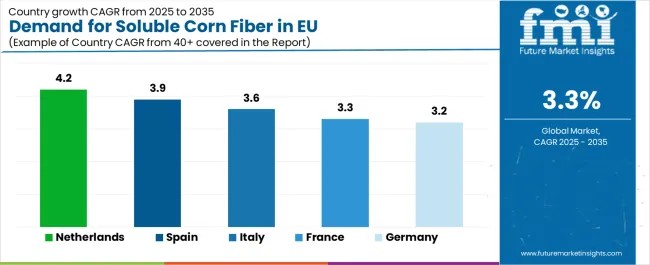
| Country | CAGR % (2025-2035) |
|---|---|
| Netherlands | 4.2% |
| Spain | 3.9% |
| Italy | 3.6% |
| France | 3.3% |
| Germany | 3.2% |
EU soluble corn fiber sales demonstrate differentiated growth across European economies, with Netherlands leading expansion at 4.2% CAGR through 2035, driven by ingredient innovation hub positioning and advanced food technology adoption. Spain shows above-average growth at 3.9% CAGR through expanding functional food sector and Mediterranean diet modernization. Italy maintains 3.6% CAGR benefiting from dairy industry fiber fortification and health-conscious consumer base. France achieves 3.3% CAGR matching EU average through balanced market development. Germany demonstrates 3.2% CAGR as Europe's largest but most mature market with established fiber ingredient adoption. Rest of Europe records 3.1% CAGR reflecting diverse regional dynamics. Overall, smaller innovative markets and Southern European food sectors outpace Northern European mature operations.
Revenue from soluble corn fiber in Germany is projected to grow at a CAGR of 3.2% through 2035 slightly below EU average maintaining Europe's largest market position at 33.1% share driven by substantial food processing industry with over 6,000 manufacturing operations, stringent technical specifications inherited from pharmaceutical-grade ingredient traditions, and comprehensive bakery sector representing Europe's largest bread consumption market. Germany's moderate growth fundamentally reflects market maturity where soluble corn fiber already extensively adopted across established fiber fortification programs, limited by saturated bakery applications and conservative formulation practices constraining rapid innovation adoption.
Major food manufacturers, including Harry Brot, Lieken Urkorn, Bahlsen, and dairy giants like DMK and Müller, systematically utilize soluble corn fiber for fiber enrichment. German market uniquely emphasizes technical documentation, analytical verification, and regulatory compliance exceeding minimum standards, creating sophisticated procurement requiring suppliers demonstrate comprehensive quality systems. Additionally, Germany's Vollkornbrot whole grain tradition and established dietary fiber awareness moderate incremental growth despite maintaining absolute volume leadership through manufacturing scale.
Maturity factors:
Revenue from soluble corn fiber in France is expanding at a solid CAGR of 3.3% matching EU average maintaining 27.7% market share driven by sophisticated food industry balancing artisanal tradition with modern ingredient innovation, growing dietary supplement sector adopting prebiotic positioning, and increasing regulatory focus on nutritional quality including Nutri-Score labeling incentivizing fiber fortification. France's steady growth reflects mature market characteristics with balanced expansion across food processing and supplement applications, supported by strong nutritional awareness and quality-focused consumer base.
Major ingredient users, including Groupe Lactalis for dairy applications, Danone for functional foods, LU biscuits, and specialized supplement manufacturers, strategically incorporate soluble corn fiber addressing fiber fortification needs. French market uniquely demonstrates pharmaceutical channel strength where dietary supplements distributed through pharmacies create premium positioning opportunities, combined with growing sports nutrition segment and established clean-label preference supporting ingredient quality focus. Regulatory environment encouraging reformulation through Nutri-Score additionally stimulates fiber fortification adoption.
Balanced growth factors:
Revenue from soluble corn fiber in Italy is growing at an above-average CAGR of 3.6% through 2035, maintaining 18.3% market share fundamentally driven by substantial dairy industry including yogurt, cheese, and functional dairy representing fertile ground for fiber fortification, growing health consciousness among urban Italian consumers, and expanding dietary supplement market adoption. Italy's stronger growth reflects ongoing transformation where traditional food categories embrace functional ingredient innovation, combined with increasing awareness of digestive health and prebiotic benefits supporting specialized supplement adoption.
Italian dairy producers, including Parmalat, Granarolo, and specialized yogurt manufacturers, increasingly incorporate soluble corn fiber for prebiotic positioning. Italian market demonstrates accelerating functional food adoption where traditional products receive modern nutritional enhancements, combined with growing sports nutrition popularity particularly among younger demographics and expanding e-commerce supplement purchasing bypassing traditional pharmacy gatekeeping. Mediterranean diet foundation paradoxically creates fiber awareness supporting supplementation despite traditional vegetable consumption.
Acceleration drivers:
Demand for soluble corn fiber in Spain is projected to grow at a robust CAGR of 3.9% second-highest among major markets maintaining 14.0% market share substantially supported by rapidly expanding functional food manufacturing sector, growing health and wellness awareness particularly among urban populations, and increasing dietary supplement adoption following Northern European consumption patterns. Spanish market outperformance fundamentally reflects dynamic food industry transformation where traditional products evolve toward functional positioning, combined with accelerating health consciousness and modernizing retail infrastructure supporting premium ingredient adoption.
Spanish food manufacturers and supplement producers systematically adopt soluble corn fiber for competitive differentiation. Spain's market benefits from growing functional beverage sector, expanding sports nutrition following fitness culture growth, and increasing retailer pressure for nutritional improvement through private-label reformulation. Additionally, Spanish food export orientation drives quality ingredient adoption meeting Northern European market standards, while domestic consumption patterns shift toward convenient functional foods supporting fiber fortification adoption.
Strong growth enablers:
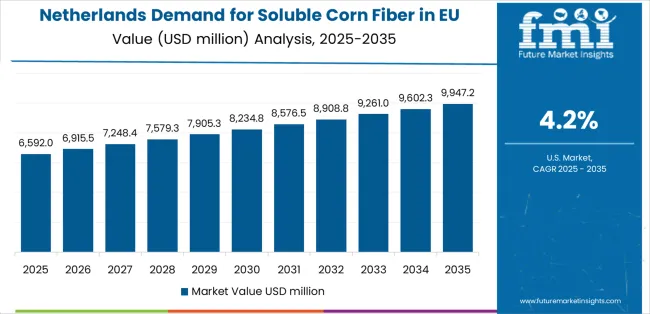
Demand for soluble corn fiber in the Netherlands is expanding at Europe's highest CAGR of 4.2% through 2035, maintaining 3.8% market share fundamentally driven by advanced food technology sector testing novel fiber applications, ingredient trading hub positioning enabling distribution innovation, and exceptional clean-label adoption with Dutch consumers demonstrating Europe's strongest transparency demands. Dutch market leadership reflects convergence of innovation culture where startups test novel formulations, trading infrastructure supporting efficient ingredient flows, and sustainability-conscious consumers driving premium ingredient penetration.
Netherlands operations, including innovative food technology companies developing plant-based products requiring fiber fortification, ingredient distributors optimizing European logistics, and supplement brands emphasizing prebiotic positioning, systematically lead fiber innovation adoption. Market uniquely benefits from Wageningen University food science leadership providing technical expertise, Rotterdam port infrastructure facilitating efficient distribution, and consumer sophistication driving evidence-based nutrition trends. Additionally, Dutch direct-to-consumer supplement brands pioneering personalized nutrition create early adoption opportunities for specialized fiber ingredients.
Market leadership factors:
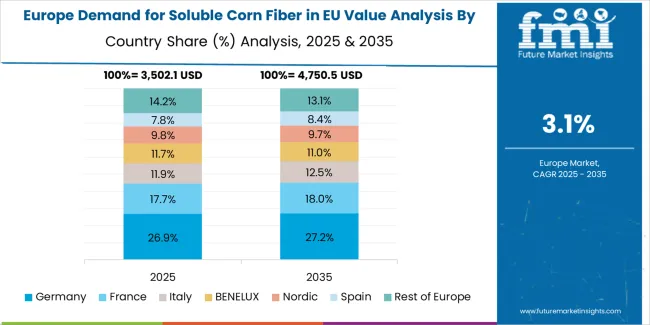
EU soluble corn fiber sales are projected to grow from USD 14,723.8 million in 2025 to USD 20,305.9 million by 2035, registering a CAGR of 3.3% over the forecast period. Netherlands is expected to demonstrate the strongest growth trajectory with a 4.2% CAGR, supported by innovation-oriented food technology sector, ingredient trading hub advantages, and progressive clean-label adoption. Spain follows with 3.9% CAGR, attributed to expanding functional food manufacturing and growing health awareness.
Germany maintains the largest share at 33.1% in 2025, driven by substantial food processing industry and technical sophistication, while growing at 3.2% CAGR reflecting market maturity. Italy demonstrates 3.6% CAGR, France records 3.3% CAGR, and Rest of Europe shows 3.1% CAGR.
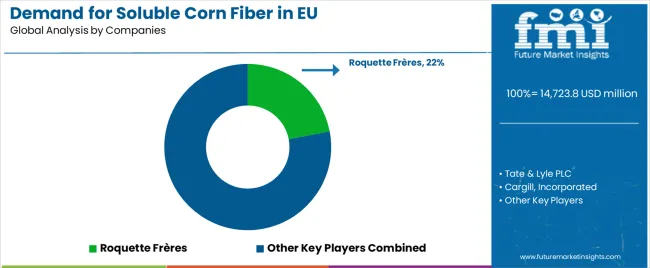
EU soluble corn fiber sales are defined by competition among multinational ingredient companies, specialized corn processing firms, and functional ingredient suppliers. Companies are investing in clinical validation programs, clean-label processing technologies, prebiotic claim substantiation, and application development services to deliver high-quality, scientifically validated, and competitively priced soluble corn fiber solutions. Strategic partnerships with food manufacturers, technical support capabilities, and marketing campaigns emphasizing prebiotic benefits and clean-label positioning are central to strengthening competitive position.
Major participants include Roquette Frères with an estimated 22.0% share, leveraging its European manufacturing presence, extensive fiber portfolio, and established food industry relationships across major markets. Roquette benefits from integrated corn processing operations, technical application laboratories, and ability to provide comprehensive fiber solutions combining soluble corn fiber with complementary ingredients, supporting food manufacturer innovation requirements.
Tate & Lyle holds approximately 18.0% share, emphasizing fiber innovation expertise, strong European distribution networks, and technical application support serving food manufacturers. Tate & Lyle's success in developing functionally optimized fiber ingredients with proven performance creates strong positioning and customer preference, supported by applications expertise and reformulation consultation services.
Cargill accounts for roughly 15.0% share through its position as integrated agricultural ingredient leader with corn wet-milling operations, providing cost-competitive supply through vertical integration. The company benefits from supply chain advantages, global sourcing capabilities, and comprehensive technical support helping food manufacturers optimize applications, supporting competitive pricing and reliable supply.
ADM represents approximately 14.0% share, supporting growth through processing innovation, extensive customer relationships, and diverse ingredient portfolio. ADM leverages corn processing expertise for technical knowledge, innovation capabilities through research partnerships, and comprehensive food industry penetration attracting manufacturers seeking reliable ingredient partners with technical depth.
Ingredion accounts for roughly 12.0% share with custom formulation capabilities, application-specific solutions, and technical service excellence. Ingredion emphasizes tailored ingredient development for specific customer requirements, technical collaboration throughout product development, and comprehensive application support differentiating through customization rather than commodity positioning.
Other companies collectively hold 19.0% share, reflecting competitive dynamics within European soluble corn fiber sales, where numerous regional ingredient suppliers, specialized prebiotic manufacturers, emerging clean-label brands, and corn processing companies serve specific food segments, geographical operations, and niche applications. This competitive environment provides opportunities for differentiation through specialized processing (organic, non-GMO), innovative molecular weight profiles, unique application expertise, and premium positioning resonating with quality-focused food manufacturers seeking differentiated fiber solutions.
| Item | Value |
|---|---|
| Quantitative Units | USD 20,371.5 million |
| Product Type (Form) | Powder, Liquid |
| Application | Dietary Supplements, Food Processing, Dairy Products, Animal Nutrition |
| Distribution Channel | B2B/Industrial, Retail & E-commerce |
| Nature | Clean-Label, Conventional |
| Countries Covered | Germany, France, Italy, Spain, the Netherlands, and the Rest of Europe |
| Key Companies Profiled | Roquette, Tate & Lyle, Cargill, ADM, Ingredion, Specialized fiber producers |
| Additional Attributes | Dollar sales by product type (form), application, distribution channel, and nature; regional demand trends across major European economies; competitive landscape analysis with integrated ingredient companies and specialized fiber producers; food manufacturer preferences for various processing formats and purity specifications; integration with prebiotic health claim substantiation and clinical validation; innovations in processing technology and clean-label certification; adoption across food processing, dietary supplements, and dairy applications; regulatory framework analysis for fiber content claims and prebiotic positioning; supply chain strategies; and penetration analysis for industrial and consumer European segments. |
The global demand for soluble corn fiber in EU is estimated to be valued at USD 14,723.8 million in 2025.
The market size for the demand for soluble corn fiber in EU is projected to reach USD 20,371.5 million by 2035.
The demand for soluble corn fiber in EU is expected to grow at a 3.3% CAGR between 2025 and 2035.
The key product types in demand for soluble corn fiber in EU are powder and liquid.
In terms of application, food processing segment to command 46.0% share in the demand for soluble corn fiber in EU in 2025.






Our Research Products

The "Full Research Suite" delivers actionable market intel, deep dives on markets or technologies, so clients act faster, cut risk, and unlock growth.

The Leaderboard benchmarks and ranks top vendors, classifying them as Established Leaders, Leading Challengers, or Disruptors & Challengers.

Locates where complements amplify value and substitutes erode it, forecasting net impact by horizon

We deliver granular, decision-grade intel: market sizing, 5-year forecasts, pricing, adoption, usage, revenue, and operational KPIs—plus competitor tracking, regulation, and value chains—across 60 countries broadly.

Spot the shifts before they hit your P&L. We track inflection points, adoption curves, pricing moves, and ecosystem plays to show where demand is heading, why it is changing, and what to do next across high-growth markets and disruptive tech

Real-time reads of user behavior. We track shifting priorities, perceptions of today’s and next-gen services, and provider experience, then pace how fast tech moves from trial to adoption, blending buyer, consumer, and channel inputs with social signals (#WhySwitch, #UX).

Partner with our analyst team to build a custom report designed around your business priorities. From analysing market trends to assessing competitors or crafting bespoke datasets, we tailor insights to your needs.
Supplier Intelligence
Discovery & Profiling
Capacity & Footprint
Performance & Risk
Compliance & Governance
Commercial Readiness
Who Supplies Whom
Scorecards & Shortlists
Playbooks & Docs
Category Intelligence
Definition & Scope
Demand & Use Cases
Cost Drivers
Market Structure
Supply Chain Map
Trade & Policy
Operating Norms
Deliverables
Buyer Intelligence
Account Basics
Spend & Scope
Procurement Model
Vendor Requirements
Terms & Policies
Entry Strategy
Pain Points & Triggers
Outputs
Pricing Analysis
Benchmarks
Trends
Should-Cost
Indexation
Landed Cost
Commercial Terms
Deliverables
Brand Analysis
Positioning & Value Prop
Share & Presence
Customer Evidence
Go-to-Market
Digital & Reputation
Compliance & Trust
KPIs & Gaps
Outputs
Full Research Suite comprises of:
Market outlook & trends analysis
Interviews & case studies
Strategic recommendations
Vendor profiles & capabilities analysis
5-year forecasts
8 regions and 60+ country-level data splits
Market segment data splits
12 months of continuous data updates
DELIVERED AS:
PDF EXCEL ONLINE
Soluble Corn Fiber Market Report - Demand, Trends & Industry Forecast 2025 to 2035
Corn Fiber Market Trends - Functional Fibers & Industry Demand 2025 to 2035
Analysis and Growth Projections for Soluble Fiber Market
Breaking Down Market Share in Europe Molded Fiber Pulp Packaging
Analysis and Growth Projections for Insoluble Dietary Fiber Business
Europe Whole Grain and High Fiber Foods Market Insights – Size & Forecast 2025–2035
Demand for Pea Fiber in EU Size and Share Forecast Outlook 2025 to 2035
Demand for Glass Fiber in EU Size and Share Forecast Outlook 2025 to 2035
Fiber Optic Gyroscope Industry Analysis in Western Europe - Trends & Forecast 2025 to 2035
Europe Molded Fiber Pulp Packaging Market Analysis – Demand, Growth & Future Outlook 2024-2034
Demand for Cold Water Soluble Starch in EU Size and Share Forecast Outlook 2025 to 2035
Western Europe Molded Fiber Pulp Packaging Market Insights – Growth & Forecast 2023-2033
Fiber Optic Probe Hydrophone (FOPH) Market Size and Share Forecast Outlook 2025 to 2035
Fiberglass Centrifugal Fan Market Size and Share Forecast Outlook 2025 to 2035
Europe Radiotherapy Patient Positioning Market Size and Share Forecast Outlook 2025 to 2035
Fiber to the Home Market Size and Share Forecast Outlook 2025 to 2035
Europe Polyvinyl Alcohol Industry Analysis Size and Share Forecast Outlook 2025 to 2035
Fiber Based Packaging Market Size and Share Forecast Outlook 2025 to 2035
Soluble-Film Cutters Market Analysis - Size and Share Forecast Outlook 2025 to 2035
Fiber Lid Market Forecast and Outlook 2025 to 2035

Thank you!
You will receive an email from our Business Development Manager. Please be sure to check your SPAM/JUNK folder too.
Chat With
MaRIA